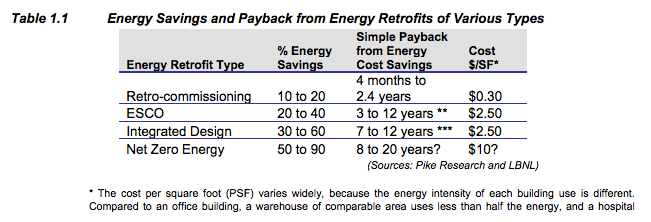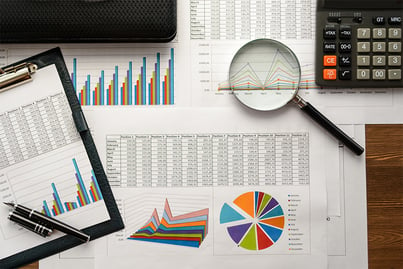When dealing with limited budgets, aging structures, and energy accountability, retrofitting is an effective approach to ensure old commercial buildings maintain tiptop performance. The gains include reduction in energy cost, improvement in equipment performance and longevity. Every year it is said that about 5 billion square feet of buildings get retrofitted when compared to new construction. A McGraw Hill construction survey found that 78 percent of building owners are planning some sort of retrofit projects in order to improve energy efficiency.
Simply put, replacing the existing lighting units as well as HVAC systems with more energy-efficient equipment is one example of a retrofit project. Other comprehensive measures include incorporating active and automated control mechanisms that can help achieve energy savings of more than 50%.
According to Pike research, the energy savings and payback from energy retrofits vary depending on the type of retrofit. The image below provides an overview of that:

Source: Pike research on energy efficiency of commercial and public buildings
However, a retrofit project is not without its own challenges. One such challenge has to do with questions around return on investment (ROI). Every retrofit project aims at improving the energy efficiency and fine-tuning of other equipment in the building. The question is whether the investments that are made give enough return on investment. Fortunately the answer is Yes and luckily, there is a way to ensure that - by leveraging the Internet of Things (IoT) combined with a sound Measurement and Verification (M&V) program.
Ensuring effective retrofits with IoT and M&V
The Internet of Things (IoT) presents an opportunity where a range of embedded devices and systems connected via the Internet work together to achieve a common goal. You can use it where sensors and smart technology control the use and operation of commercial building equipment such as HVAC systems, lighting, and plug loads.
IoT’s biggest advantage lies in its ability to provide real-time data, which is priceless in every retrofit project. Other benefits include detection and diagnoses of faulty equipment, energy efficiency, and enhanced profitability.
Measurement and Verification on the other hand is a process that involves planning, measuring, collecting and analyzing data in a bid to establish and report energy savings following the implementation of Energy Conservation Measures (ECMs) within a facility, as is the case in retrofit projects. In its basic, Measurement and Verification ensures that a building retrofit yields the desired results.
Before the coming of IoT, tracking and collecting building performance data was manually done using meter readings and data obtained from utility bills on a monthly basis. This was a tedious, less accurate and slow process. Fortunately, these problems belong in the past now thanks to advanced technology like the IoT. Today, it is possible to monitor and track a building’s performance related data on the go, which is very important for M&V processes.
The M&V processes where IoT has proven beneficial include:
- The selection of target areas
- Meter installation, calibration and maintenance
- Data collection and validation
- Establishment of baselines
- Identification of the most effective retrofits from data analyses
- Calculation of energy savings and Return on Investment
- Implementation and monitoring
At the heart of all these operations is data. Data is important for the eventual success of building retrofits. IoT can provide accurate and comprehensive data upon which a M&V program feeds on leading to a positive impact on a retrofit project.
Maximizing ROI using IoT
Thanks to IoT and smart building solutions, data can now be monitored and tracked on a real-time basis at the basic levels of equipment and sub-systems that are found in commercial buildings. This makes it possible for contractors to determine if a retrofit will be effective and also prove the degree of its ROI at the planning stage of the retrofit and not after its implementation.
Data obtained allows stakeholders to make informed decisions that will provide both immediate and long-term benefits. One such benefit is maximizing a retrofit’s Return on Investment.
The following are areas where IoT can help you maximize ROI of your retrofit project:
ROI through energy efficiency:
IoT can provide accurate data related to ECMs. This way the value of each ECM can be determined and measured. This is very important in retrofits because it is a concrete way to prove the value- ROI of the project.
With data in hand, providing estimated savings and ROI becomes easy. And this means you can prove to key stakeholders that the retrofit project is worth every cent.
That’s not all; obtaining data on the go as made possible with IoT will help in establishing a baseline for estimated savings expected from each intervention measure. What this does is that it provides a proof to the effect that the retrofit project is less risky as such making financing options at lower cost readily available.
Lastly, IoT validates the M&V program by providing real-time data that can be used to monitor the project continuously thus increasing the chance of project success and ROI.
Determining the scope of a retrofit project:
By providing real-time data, IoT can help determine the scope of a retrofit project. What this means is that, data can be used to eliminate or favor certain upgrades based on their needs and savings they can produce often leading to adjustments in the scope of the retrofit project.
IoT will help in identifying areas where investment in upgrades will lead to quick paybacks. Decisions to alter of define the scope of the project will then made on account of hard data obtained rather than on assumptions or wishful thinking.
By accurately determining profitable upgrades thanks to data gathered from the IoT, the ROI can be guaranteed.
Accountability of claims and proposals:
In business, retrofitting included, it is not uncommon to find vendors or contractors making bogus claims that can lead to terrible outcomes.
However, IoT provides you a means to track and measure the effectiveness of the ECMs will help you to hold them accountable to their claims and it will also help you determine the time and budget a vendor or contractor is worth. With this in place, you can be guaranteed of a better result.
It is the building performance data obtained with an IoT smart building solution at the granular level that will provide you with an informed basis for reviewing the estimated savings of a proposal.
Increasing the real estate value and rental rates:
Retrofits often involve the replacement of equipment in some cases while in most other cases newer technologies have positive impact on productivity, health and morale.
To succeed with the higher ROI however, accurate historic data is required for cost-benefit analysis. Here, IoT can provide data relating to horsepower, voltage, rpm, gallons per minute (GPM), annual run time and energy costs associated with a particular system.
IoT makes these data readily available on demand, which can then be used to determine the most accurate value of the long-term value of retrofits.
Conclusion
The ability of an IoT smart building solution to provide real-time equipment-level data on demand is its biggest selling point when it comes to efforts geared towards maximizing ROI of retrofit projects.
This data is in turn used to make informed decisions in various aspects of the retrofit including the planning and executing Measurement & Verification process which in turn translates to project success thus helping you maximize the return on investment of your retrofit project.





